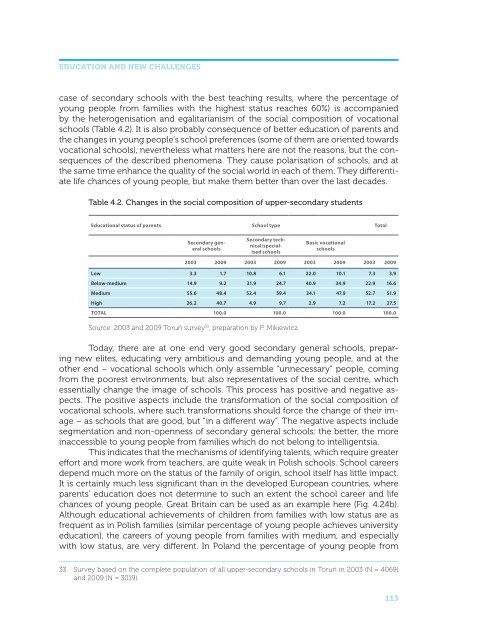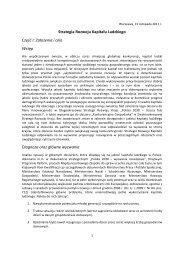Education and new challenges - Raport Polska 2030
Education and new challenges - Raport Polska 2030
Education and new challenges - Raport Polska 2030
You also want an ePaper? Increase the reach of your titles
YUMPU automatically turns print PDFs into web optimized ePapers that Google loves.
<strong>Education</strong> <strong>and</strong> <strong>new</strong> <strong>challenges</strong><br />
case of secondary schools with the best teaching results, where the percentage of<br />
young people from families with the highest status reaches 60%) is accompanied<br />
by the heterogenisation <strong>and</strong> egalitarianism of the social composition of vocational<br />
schools (Table 4.2). It is also probably consequence of better education of parents <strong>and</strong><br />
the changes in young people’s school preferences (some of them are oriented towards<br />
vocational schools), nevertheless what matters here are not the reasons, but the consequences<br />
of the described phenomena. They cause polarisation of schools, <strong>and</strong> at<br />
the same time enhance the quality of the social world in each of them. They differentiate<br />
life chances of young people, but make them better than over the last decades.<br />
Table 4.2. Changes in the social composition of upper-secondary students<br />
<strong>Education</strong>al status of parents School type Total<br />
Secondary general<br />
schools<br />
Secondary technical/specialised<br />
schools<br />
Basic vocational<br />
schools<br />
2003 2009 2003 2009 2003 2009 2003 2009<br />
Low 3.3 1.7 10.8 6.1 22.0 10.1 7.3 3.9<br />
Below-medium 14.9 9.2 31.9 24.7 40.9 34.9 22.9 16.6<br />
Medium 55.6 48.4 52.4 59.4 34.1 47.9 52.7 51.9<br />
High 26.2 40.7 4.9 9.7 2.9 7.2 17.2 27.5<br />
TOTAL 100.0 100.0 100.0 100.0<br />
Source: 2003 <strong>and</strong> 2009 Toruń survey 33 , preparation by P. Mikiewicz.<br />
Today, there are at one end very good secondary general schools, preparing<br />
<strong>new</strong> elites, educating very ambitious <strong>and</strong> dem<strong>and</strong>ing young people, <strong>and</strong> at the<br />
other end – vocational schools which only assemble “unnecessary” people, coming<br />
from the poorest environments, but also representatives of the social centre, which<br />
essentially change the image of schools. This process has positive <strong>and</strong> negative aspects.<br />
The positive aspects include the transformation of the social composition of<br />
vocational schools, where such transformations should force the change of their image<br />
– as schools that are good, but “in a different way”. The negative aspects include<br />
segmentation <strong>and</strong> non-openness of secondary general schools: the better, the more<br />
inaccessible to young people from families which do not belong to intelligentsia.<br />
This indicates that the mechanisms of identifying talents, which require greater<br />
effort <strong>and</strong> more work from teachers, are quite weak in Polish schools. School careers<br />
depend much more on the status of the family of origin, school itself has little impact.<br />
It is certainly much less significant than in the developed European countries, where<br />
parents’ education does not determine to such an extent the school career <strong>and</strong> life<br />
chances of young people. Great Britain can be used as an example here (Fig. 4.24b).<br />
Although educational achievements of children from families with low status are as<br />
frequent as in Polish families (similar percentage of young people achieves university<br />
education), the careers of young people from families with medium, <strong>and</strong> especially<br />
with low status, are very different. In Pol<strong>and</strong> the percentage of young people from<br />
33 Survey based on the complete population of all upper-secondary schools in Toruń in 2003 (N = 4069)<br />
<strong>and</strong> 2009 (N = 3019).<br />
113







